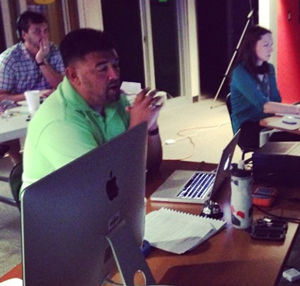Broadcast Town Meeting: What’s made your job a little easier in recent years?
 At different times on Thursday evenings I have dropped in on the “Jerd Chat” (#jerdchat) on Twitter. I really enjoy reading other journalism teachers’ contributions to discussions covering topics so many of us relate to, and every once in a while I chime in myself.
At different times on Thursday evenings I have dropped in on the “Jerd Chat” (#jerdchat) on Twitter. I really enjoy reading other journalism teachers’ contributions to discussions covering topics so many of us relate to, and every once in a while I chime in myself.
When I began trying to teach broadcast journalism in the fall of 1989, I was alone on an island, with 65 students sharing one camera, one VCR, and one TV. It was so difficult to find the help I desperately needed. Now, we are everywhere, and by “we,” I mean journalism teachers whose kids are using video to reach their audience and share great stories.
For my next few posts here, I contacted colleagues from across the country, and asked them to provide insights based on their specific broadcast journalism teaching experiences. Each of them understood this would be a great way to “pay it forward,” and I sincerely appreciate the time they took to provide feedback. A dozen teachers with over 120 years of experience teaching broadcasting participated, and while you will not see a dozen answers to each question I pose, you will read content from all of them in the weeks ahead.
I chose to use the Q and A format. Let’s get this first “town meeting” underway.
Q: Tell us about a policy or practice you have put in place that has made your job as a broadcast teacher a little easier in recent years.
A: “Made a point of making sure kids slowly be aware that it is their program and THEY need to take charge of it over time, so my influence decreases and their influence increases.”
-Steven Cortez, Blue Valley Southwest High School, Overland Park, KS
A: “We reduced our newsmagazine show from six to four times a year to ensure more time for thoughtful (non-rushed) production and for better anchor shots. As of this year, with our 56th show in the can, we decided to end the show and to focus on creating for a Vimeo channel to allow us to be more timely and creative. The drive for a show faded, and the students thought the whole franchise had plateaued.”
-Jon Reese, Decatur High School, Decatur, GA
A: “We have all of our broadcast journalism students sign a morality statement. It includes such things as social media behavior, public decency and penalties for any infractions of school rules. It has made it easier to dismiss kids from the program who do not represent appropriately. They are the FACE of our school and they must have good reputations outside of the program in order to be respected.”
-Robyn Gramly, Prosper High School, Prosper, TX
A: “When my students turn in story ideas and then select stories for their broadcasts, I require them to focus on balance. Their ideas must include at least one news, one profile, one academic, one sports, and one “fun” idea. This prevents shows that are too silly or too serious. It works!”
-Jeff Kuchno, Oakville High School, St. Louis, MO
A: “ I’ve gone paperless for many things. I use Quia.com to create online assignments and quizzes. I use Livebinder.com to post handouts, forms and worksheets. My students use google docs to manage the rundown for our daily and monthly shows, and we built a homemade website that acts like a hub for all of this (as well as a place for our audience to interact). At Broward Teen News (my previous teaching assignment in Florida), I used to have a barcode scanner to check out equipment with an extensive online digital inventory system that I built in Filemaker Pro, but I haven’t made that happen at Norwood just yet. I highly recommend this. It takes a little bit of work at that front end, but totally worth it.”
-Jeb Brunt, Norwood High School, Norwood, MA
A: “I have a rough draft due date for each package a week prior to air. I watch each one and write down revision suggestions. No matter how busy I am, I make sure to get my comments to my students the VERY next day. My News Director also does this. The students then have two sets of comments to use as they have 3-4 days to revise.”
-Elaine McDonald, Lee’s Summit High School, Lee’s Summit, MO
A: “Four years ago (2011-2012), Bixby High School had one journalism class – yearbook. The administration was cutting the newspaper class when I convinced them to let me form an online newspaper class. That same year I scrapped together enough students for a Journalism One (J1) class. Little did I know at the time, but adding J1 was an essential piece for developing my ultimate goal at Bixby – to offer a full range of journalism classes. J1 allowed me to develop students’ learning experiences without the pressure of product deadlines. It also let me dabble in teaching video journalism. In many ways I was testing the waters (so to speak), evaluating the interest of students as I knew that I ultimately wanted to have a broadcasting class. I wasn’t really sure how I was going to do that since my district didn’t have the infrastructure for such things. With the few students that I had developed in J1, I added sports broadcasting and video journalism as part of the online newspaper experience.”
-Dee Harris, Bixby High School, Bixby OK
A: “I don’t know if I have done much to make my job easier. Instead, I seem to create more work for myself because I do love it! But, with that being said…I do make sure I am always in a good mood, smiling, and joking, and happy to be at school (or at least appear that way) when I am around my students. I want them to feel welcome and know that I enjoy teaching them and I am passionate about what I am doing.
-Pam Dixon, Lake Charles-Boston Academy of Learning. Lake Charles, LA





I’ve just started out with broadcasting, but I’ve headed up yearbook for over three years now. Perhaps one of the biggest motivators for my students is to be included in business meetings and financial decisions. My yearbook class has been on point this year because they were present when our yearbook representative and I had a frank discussion about the $4,000 difference between his company and a competitor. They saw the seriousness of spending thousands of community-generated dollars on a product, and the need for that product to be worth the expense. And they’ve stepped up to the challenge like no class before them has.
As for my broadcasting club, I hand them every email from our community, and pass along every message from viewers. They have been present at community organization meetings, school board meetings, and radio shows to speak on their own behalf, and have benefitted from the overwhelming support (sometimes monetary donations have been lavished) of their viewers and listeners.
Johnny,
That is awesome. Having the kids get a taste of the financial side from the beginning. That is brilliant. Thanks for sharing that.
-Dave